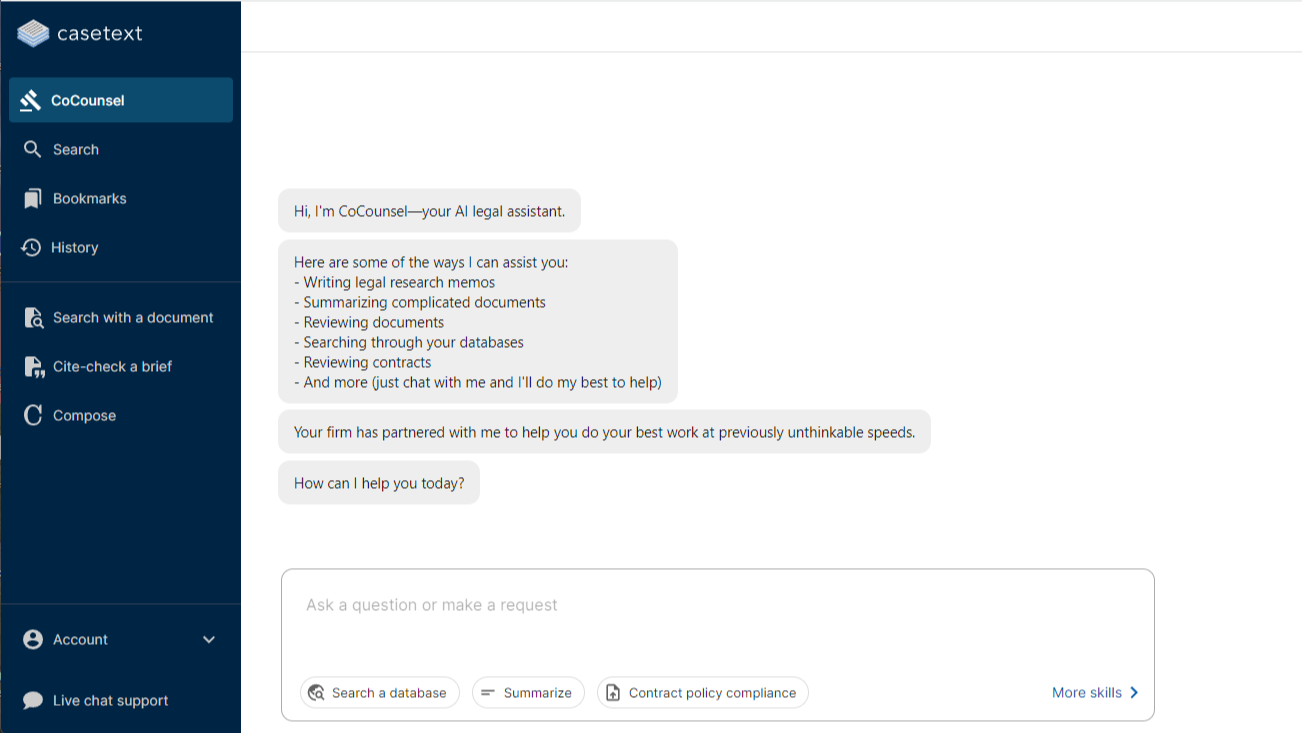
CaseText Compose: Complete Buyer's Guide
Litigation Automation, plus just add a touch of human
CaseText Compose was an AI-powered legal brief automation platform that transformed litigation workflows through intelligent document generation and case law analysis. Discontinued as of March 31, 2025, following Thomson Reuters' acquisition, it represented a significant advancement in legal AI automation before its integration into Thomson Reuters' broader legal technology ecosystem[143].
Market Position & Maturity
Market Standing
CaseText Compose occupied a pioneering position in the legal brief automation market before its discontinuation, representing one of the first commercially available systems focused on end-product generation rather than research facilitation alone[131][136].
Company Maturity
Technology maturity was evidenced through comprehensive functionality including concept-based legal research, automated argument assessment, and seamless Microsoft Office integration[131][144].
Growth Trajectory
Strategic acquisition by Thomson Reuters represented significant market validation and strategic value recognition[143].
Industry Recognition
Enterprise customer validation included implementation by notable firms such as Ogletree Deakins, Sheppard Mullin, and Bowman and Brooke, demonstrating market acceptance among sophisticated legal practices[131][147].
Longevity Assessment
Current market reality requires legal professionals to evaluate Thomson Reuters' integrated legal AI offerings rather than CaseText Compose as an independent solution[143].
Proof of Capabilities
Customer Evidence
Enterprise customer implementations included deployment at Ogletree Deakins, Sheppard Mullin, and Bowman and Brooke, demonstrating market acceptance among sophisticated legal practices[131][147].
Quantified Outcomes
Quantified performance evidence from a comprehensive study involving 13 experienced litigators from AmLaw 200 firms demonstrated substantial efficiency and quality improvements[134][142].
Case Study Analysis
Executive demonstration results provided compelling real-world evidence through CEO Jake Heller's demonstration of drafting a complete 20-page motion in under 30 minutes[139].
Market Validation
Customer satisfaction evidence from the broader CaseText platform revealed strong user approval, with customers highlighting responsive customer service and technical support quality[133].
Reference Customers
Notable firm implementations included Ogletree Deakins, Sheppard Mullin, and Bowman and Brooke[131][147].
AI Technology
CaseText Compose operated through sophisticated NLP-driven analysis that fundamentally transformed traditional brief preparation workflows through intelligent automation and case law integration[131].
Architecture
Database integration architecture connected multiple legal research sources including case law databases, treatises, and brief banks through unified search and analysis capabilities[131].
Primary Competitors
Primary competitive landscape included established legal research platforms like Westlaw and Lexis[133].
Competitive Advantages
Technology advantages included concept-based legal research capabilities and automated argument assessment that distinguished it from keyword-based competitors[131].
Market Positioning
Market differentiation positioned CaseText Compose among the early commercially available brief drafting automation systems, differentiating from traditional legal research tools by focusing on end-product generation rather than research facilitation alone[131][136].
Key Features

Pros & Cons
Use Cases
Integrations
Pricing
Featured In Articles
Comprehensive analysis of AI Expert Witness Matching for Legal/Law Firm AI Tools for Legal/Law Firm AI Tools professionals. Expert evaluation of features, pricing, and implementation.
How We Researched This Guide
About This Guide: This comprehensive analysis is based on extensive competitive intelligence and real-world implementation data from leading AI vendors. StayModern updates this guide quarterly to reflect market developments and vendor performance changes.
147+ verified sources per analysis including official documentation, customer reviews, analyst reports, and industry publications.
- • Vendor documentation & whitepapers
- • Customer testimonials & case studies
- • Third-party analyst assessments
- • Industry benchmarking reports
Standardized assessment framework across 8 key dimensions for objective comparison.
- • Technology capabilities & architecture
- • Market position & customer evidence
- • Implementation experience & support
- • Pricing value & competitive position
Research is refreshed every 90 days to capture market changes and new vendor capabilities.
- • New product releases & features
- • Market positioning changes
- • Customer feedback integration
- • Competitive landscape shifts
Every claim is source-linked with direct citations to original materials for verification.
- • Clickable citation links
- • Original source attribution
- • Date stamps for currency
- • Quality score validation
Analysis follows systematic research protocols with consistent evaluation frameworks.
- • Standardized assessment criteria
- • Multi-source verification process
- • Consistent evaluation methodology
- • Quality assurance protocols
Buyer-focused analysis with transparent methodology and factual accuracy commitment.
- • Objective comparative analysis
- • Transparent research methodology
- • Factual accuracy commitment
- • Continuous quality improvement
Quality Commitment: If you find any inaccuracies in our analysis on this page, please contact us at research@staymodern.ai. We're committed to maintaining the highest standards of research integrity and will investigate and correct any issues promptly.